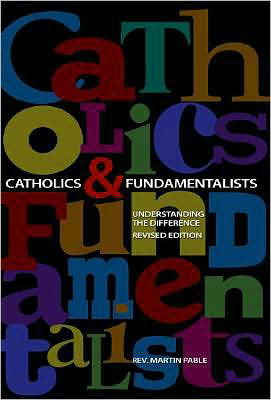
|
Posted June 3, 2008
Book: Catholics & Fundamentalists: Understanding and Response Author: Rev. Martin Pable Acta Publications. Skokie, IL. 2008. Pp. 95 An Excerpt from the Jacket:
For over fifteen years, Fr. Martin Pable’s book Catholics and Fundamentalists has helped Catholics understand and respond to the Protestant fundamentalist phenomenon. This newly revised edition continues that important work by also addressing the rise of Islamic and Catholic fundamentalism and the challenges of modern fundamentalism for the Catholic faith. Catholics and Fundamentalists clearly and concisely explains: The origins of modern fundamentalism Fundamentalist interpretations of sacred texts Catholic and fundamentalist understandings of salvation Advice for how to respond to fundamentalism What to do when a loved one becomes a fundamentalist An Excerpt from the Book: Catholic Fundamentalism Like Catholics in general, fundamentalist Catholics accept the view of salvation taught by the Church. Briefly, salvation begins with baptism, is deepened and furthered by participation in the other sacraments and by obedience to the commandments and culminates with the gift of eternal life with God in heaven. Catholic fundamentalists put a great deal of emphasis on holding correct beliefs, as taught by the hierarchy and summarized in The Catechism of the Catholic Church. Fundamentalist parents tend to be extremely involved in their childrens’ Catholic schools and religious education programs, and they are often overly critical of the teachers, their methods, and teaching resources. When it comes to higher education, these fundamentalist Catholics are often disheartened with Catholic colleges and universities; they perceive these schools as being too secular in their outlook and watering down or even opposing traditional Catholic beliefs and practices. In response to this, many fundamentalist Catholics parents have begun sending their children to one of a number of recently founded colleges and universities that expressly uphold Catholic theology and spiritual values. Fundamentalist Catholics are usually highly visible in the pro-life movement. They turn out in large numbers for pro-life marches and rallies. They pray and picket at abortion clinics and sometimes try to talk women out of going through with an abortion. They provide help for women who are needy but choose to have their baby. They lend their support to candidates for public office who hold to pro-life positions and work to defeat those who are pro-choice. Also, in line with Church teaching, they are likely to teach and practice natural family planning as an alternative to artificial contraception. Besides their faithful attendance at Sunday and holy day Masses, these Catholics often engage in devotional practices as aids to salvation. The rosary is a favorite prayer for many, as well as the Divine Mercy chaplet. Some try to spend an hour or more each week in adoration of Christ in the Blessed Sacrament. The lives of the Virgin Mary and the saints have a strong appeal for these Catholics; they provide inspiration to live their faith generously in a secularized world. This interest in Mary and the saints has produced an abundance of new books, videos, and DVD’s that are readily available, especially through a number of Catholic websites on the Internet. And speaking of media, it has been mostly traditional Catholics who have founded new Catholic radio networks as well as the only 24-hour television station EWTN. In fairness, it must be said that not all Catholics who regard themselves as “conservative” or “traditional” are fundamentalists. Recall the two special characteristics of fundamentalism: intolerance and militancy. Many conservatives and traditionalist Catholics, while they may be strong in their viewpoints, do not demonstrate those qualities. At the same time, we must acknowledge the darker side of Catholic fundamentalism. The passion for orthodoxy can sometimes trump basic charity and decency. It is sad to see good teachers or parish staff members lose their jobs because of the pressure of a small group of conservative parishioners. Often the cases could have been resolved fairly and peacefully if the parties had been willing to dialogue in a true Christian spirit. Fundamentalist Catholics can be angry and mean-spirited in their criticism of their “adversaries.” The conviction that “we alone possess the truth” can undercut any attempt to reach an understanding or mutually agreeable compromise. Moreover, forbidding our young people to question their beliefs does not prepare them well to meet the objections and attacks on their faith that will inevitably come when they encounter the wider world. There is no need for the “deconstruction” that sometimes goes on in liberal Scripture and theology classes. But students must be informed about the honest questions that scholars and scientists raise about matters of faith and be equipped to respond intelligently. Finally, fundamentalist Catholics must remember that theirs is not the only way to salvation. It is distressing to see people trying to impose their personal devotions and religious practices on others: “How can you call yourself a Catholic if you don’t follow this or that?” The truth is that one of the great blessings of being Catholic is that, within the framework of creed-sacraments-commandments, there are many paths to salvation as well as to holiness. Table of Contents: Introduction What is fundamentalism? Sacred books: sources of belief “Are you saved” Catholic responses to fundamentalism What Catholics can learn from fundamentalists Conclusion Sources and suggestions for further reading |
|
